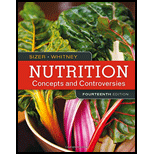
Concept explainers
To review:
The eating pattern approach to the dietary guidelines is preferred over the limiting of the specific nutrient such as percentage of calories from fats.
Given:
The two approaches are given such that to follow a given pattern of dietary guidelines and limiting a specific nutrient such as percentage of calories from fats.
Introduction:
There are guidelines for selecting, cooking, and eating pattern recommended by an authority in the form of guidelines. The need of such guidelines occurred due to the possibility of some kind of risks associated to the eating pattern. Limiting of specific nutrient from a balanced diet by some percentage is another approach to avoid the risk associated with the particular nutrient supplementing foods in the diet.
Want to see the full answer?
Check out a sample textbook solution
Chapter 5 Solutions
Nutrition: Concepts and Controversies
 Comprehensive Medical Assisting: Administrative a...NursingISBN:9781305964792Author:Wilburta Q. Lindh, Carol D. Tamparo, Barbara M. Dahl, Julie Morris, Cindy CorreaPublisher:Cengage Learning
Comprehensive Medical Assisting: Administrative a...NursingISBN:9781305964792Author:Wilburta Q. Lindh, Carol D. Tamparo, Barbara M. Dahl, Julie Morris, Cindy CorreaPublisher:Cengage Learning Nutrition Through The Life CycleHealth & NutritionISBN:9781337919333Author:Brown, Judith E.Publisher:Cengage Learning,Lifetime Physical Fitness & WellnessHealth & NutritionISBN:9781337677509Author:HOEGERPublisher:Cengage
Nutrition Through The Life CycleHealth & NutritionISBN:9781337919333Author:Brown, Judith E.Publisher:Cengage Learning,Lifetime Physical Fitness & WellnessHealth & NutritionISBN:9781337677509Author:HOEGERPublisher:Cengage





